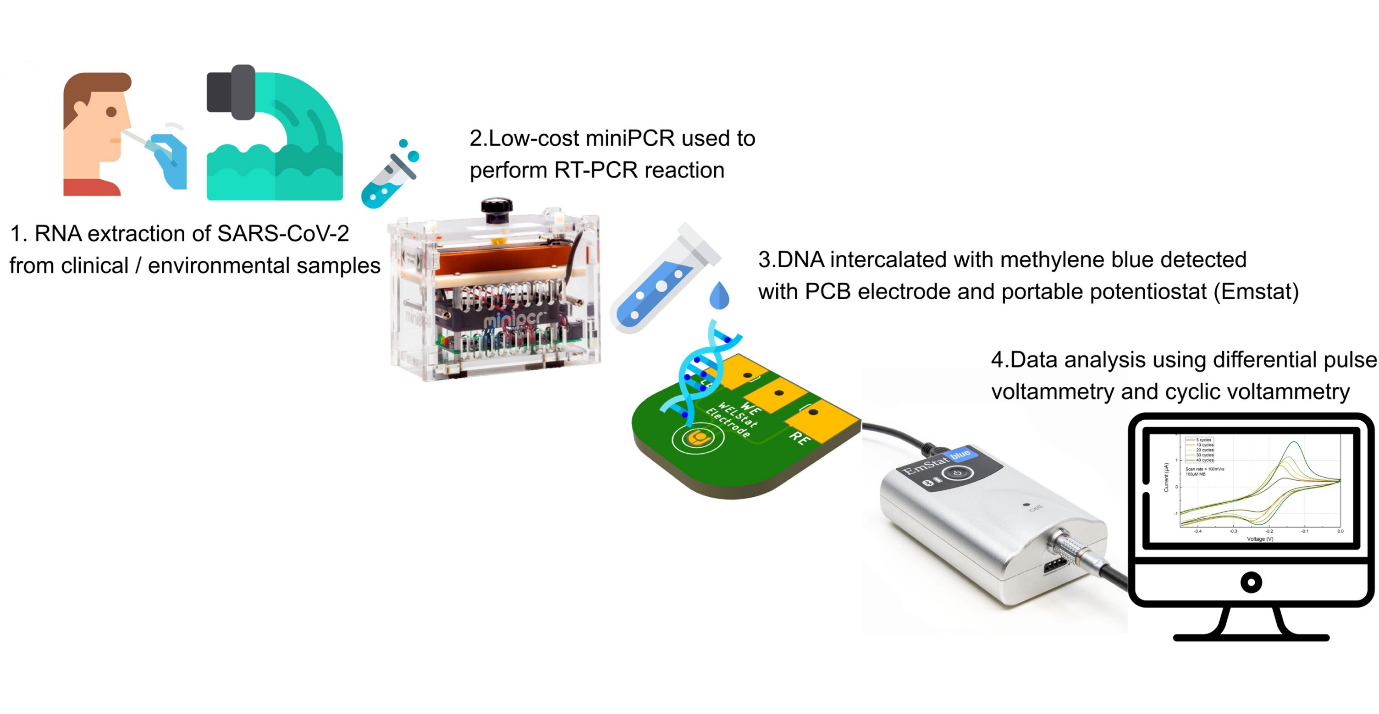Solution to Widespread Monitoring of Covid-19: A Sensor
2 March 2022 | Srilagna Sahoo, edited by Adil Khan
The COVID-19 pandemic has been a tough challenge for society and the global economy. Necessary measures are limited to avoiding social gathering for effective screening and containment of the SARS-CoV-2 virus. These are quite difficult to implement in a large country like India, where many people depend upon small businesses for their survival, and enforcing social distancing norms is hard.
Wastewater-based epidemiology (WBE) has been widely recognised as a surveillance tool to track COVID-19 prevalence in a particular area. However, the standard qPCR technique needs expensive laboratory infrastructure to perform the virus screening test. Keeping in mind cost vs benefit, population density and better containment of the virus, a group of scientists from University of Strathclyde and IIT Bombay jointly developed a low-cost biosensor, which can detect genetic material of SARS-COVID-2 virus in waste water. The detector is able to identify COVID affected areas inexpensively and faster compared to individual testing of people. Hence, we are able to map the disease’s prevalence over a larger geographic area faster and more affordably.
The group performed wastewater analysis from a sample of a sewage treatment plant in Mumbai. The sensor is capable of detecting the virus at concentrations as low as 10 pg/μl. The sensor is based on a portable printed circuit board (PCB) and its electrodes are reusable, easy to clean, and have a long shelf-life. This attracts the research interest towards the electrochemical sensor. The estimated manufacturing cost is approximately as low as USD 0.55 (equivalent to ₹40) per electrode for quantities of 100.

The workflow implemented in this research for SARS-CoV-2 nucleic acid detection
Work began in the Electrical Engineering department during the lockdown period (May 2020) in collaboration with the Biosciences and Bioengineering department at IIT Bombay. Santosh, a Ph.D. student in Biosciences who was involved in this work, informs us that "The waste water sample was collected from Chembur, Mumbai area and processed to extract the genome of SARS COVID-19 dead virus. It was a complete lockdown and resources were limited. In this panic condition, Kirti came forward to collect the sample while wearing the PPE kit." Kirti Megha, herself a post-doctoral researcher from the BSBE department collected waste water and isolated the genome. The conceptualization and work direction was led by Sailesh, a PhD student. He also helped in amplification of the DNA fragments.
SARS-CoV-2, the virus responsible for the COVID-19 disease is a single-stranded RNA virus. Prof. Kiran and his biosciences group successfully isolated the viral RNA from waste water, converted it to double stranded DNA and performed the amplification of genetic material to detect the virus. Following this, the processed sample (DNA fragment) was ready for electrical characterization with the help of PCB electrodes.
Despite adverse conditions, the experiments followed standard protocols. The work was kicked off by Prof. Siddharth Tallur from the Electrical Engineering department along with Maheshwar and Mahesh from the WEL lab during lockdown. Ruchira, a doctoral student under Prof. Tallur informs us that they tested the processed sample (amplified DNA fragment) with the developed sensors. The PCB electrodes were designed by Maheshwar within the Wadhwani Electronics Lab (WEL). He was responsible for programming the controller and implementation. He also assisted the group for the electrical characterization of the sensor. Initially, the work was started with commercially available sensors which were costly (₹500 to 700 per piece) to test the feasibility of the project. Later, owing to internal development of the electrodes, the cost went down to ₹40 per piece for batch production.
The team faced obstacles in obtaining raw materials (reagents for PCR reaction) during the lockdown. However, they were able to manage with resources on hand and achieved results using the available materials. Ruchira said that she got continuous support from Prof. Tallur and Prof. Kiran and she is thankful to be a part of this project. In the words of Prof. Siddharth Tallur, "The method we have developed is not just applicable to SARS-CoV-2, it could be applied to any other virus, thereby it is very versatile. In the future, we'll focus on optimising the assay further to increase accuracy and also integrate the assay with a portable platform to handle both PCR reaction and electrochemical measurement."
Reference - Kumar MS, Nandeshwar R, Lad SB, et al. Electrochemical sensing of SARS-CoV-2 amplicons with PCB electrodes. Sensors and Actuators B: Chemical. 2021;343:130169. doi:10.1016/j.snb.2021.130169